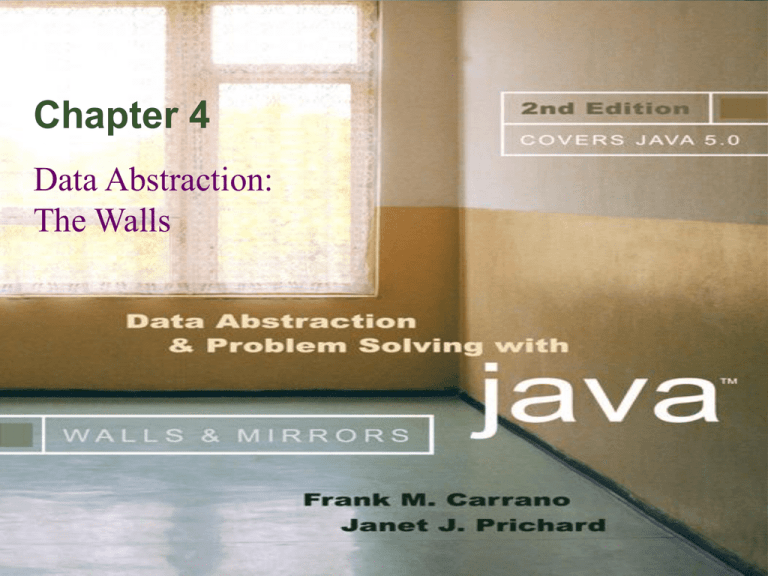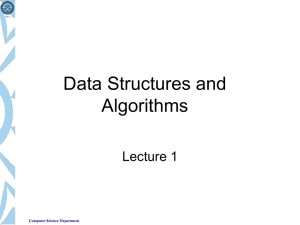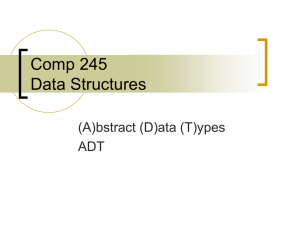
Chapter 4
Data Abstraction:
The Walls
Abstract Data Types
• Modularity
– Keeps the complexity of a large program manageable
by systematically controlling the interaction of its
components
– Isolates errors
– Eliminates redundancies
– A modular program is
• Easier to write
• Easier to read
• Easier to modify
© 2004 Pearson Addison-Wesley. All rights reserved
4-2
Abstract Data Types
• Procedural abstraction
– Separates the purpose and use of a module from its
implementation
– A module’s specifications should
• Detail how the module behaves
• Identify details that can be hidden within the module
• Information hiding
– Hides certain implementation details within a module
– Makes these details inaccessible from outside the
module
© 2004 Pearson Addison-Wesley. All rights reserved
4-3
Abstract Data Types
Figure 4.1
Isolated tasks: the implementation of task T does not affect task Q
© 2004 Pearson Addison-Wesley. All rights reserved
4-4
Abstract Data Types
• The isolation of modules is not total
– Methods’ specifications, or contracts, govern how they interact
with each other
Figure 4.2
A slit in the wall
© 2004 Pearson Addison-Wesley. All rights reserved
4-5
Abstract Data Types
• Typical operations on data
– Add data to a data collection
– Remove data from a data collection
– Ask questions about the data in a data collection
• Data abstraction
– Asks you to think what you can do to a collection of
data independently of how you do it
– Allows you to develop each data structure in relative
isolation from the rest of the solution
– A natural extension of procedural abstraction
© 2004 Pearson Addison-Wesley. All rights reserved
4-6
Abstract Data Types
• Abstract data type (ADT)
– An ADT is composed of
• A collection of data
• A set of operations on that data
– Specifications of an ADT indicate
• What the ADT operations do, not how to implement
them
– Implementation of an ADT
• Includes choosing a particular data structure +
algorithms
© 2004 Pearson Addison-Wesley. All rights reserved
4-7
Abstract Data Types
• Data structure
– A construct that is defined within a programming
language to store a collection of data
– Example: arrays
• ADTs and data structures are not the same
• Data abstraction
– Results in a wall of ADT operations between data
structures and the program that accesses the data within
these data structures
© 2004 Pearson Addison-Wesley. All rights reserved
4-8
Abstract Data Types
Figure 4.4
A wall of ADT operations isolates a data structure from the program that uses it
© 2004 Pearson Addison-Wesley. All rights reserved
4-9
Specifying ADTs
• In a list (sequence of items)
– Except for the first and last
items, each item has
• A unique predecessor
• A unique successor
– Head or front
• Does not have a predecessor
– Tail or end
• Does not have a successor
Figure 4.5
list A grocery
© 2004 Pearson Addison-Wesley. All rights reserved
4-10
The ADT List
• ADT List operations
–
–
–
–
–
–
–
–
Create an empty list
Determine whether a list is empty
Determine the number of items in a list, i.e., size
Add an item at a given position in the list
Remove the item at a given position in the list
Remove all the items from the list
Retrieve (get) the item at a given position in the list
Display all the items in the list
• Items are referenced by their position within the
list
© 2004 Pearson Addison-Wesley. All rights reserved
4-11
The ADT List
• Specifications of the ADT operations
– Define the contract for the ADT list
– Do not specify how to store the list or how to
perform the operations
• ADT operations can be used in an
application without the knowledge of how
the operations will be implemented
• Pseudo code on page 113
© 2004 Pearson Addison-Wesley. All rights reserved
4-12
© 2004 Pearson Addison-Wesley. All rights reserved
4-13
The ADT Sorted List
• The ADT sorted list
– Maintains items in sorted order
– Inserts and deletes items by their values, not
their positions
• Pseudo code on pages 184, 857, and 858
© 2004 Pearson Addison-Wesley. All rights reserved
4-14
© 2004 Pearson Addison-Wesley. All rights reserved
4-15
ADT Sorted List – Pre and Postconditions
© 2004 Pearson Addison-Wesley. All rights reserved
4-16
© 2004 Pearson Addison-Wesley. All rights reserved
4-17
Designing an ADT
• The design of an ADT should evolve
naturally during the problem-solving
process
• Questions to ask when designing an ADT
– What data does a problem require?
– What operations does a problem require?
© 2004 Pearson Addison-Wesley. All rights reserved
4-18
Implementing ADTs
• Choosing the data structure to represent the ADT’s
data is a part of implementation
– Choice of a data structure depends on
• Details of the ADT’s operations
• Context in which the operations will be used
• Implementation details should be hidden behind a
wall of ADT operations
– A program would only be able to access the data
structure using the ADT operations
© 2004 Pearson Addison-Wesley. All rights reserved
4-19
Implementing ADTs
Figure 4.8
ADT operations provide access to a data structure
© 2004 Pearson Addison-Wesley. All rights reserved
4-20
Implementing ADTs
Figure 4.9
Violating the wall of ADT operations
© 2004 Pearson Addison-Wesley. All rights reserved
4-21
Java Mechanism for ADT
Specification
• The specification is documented as an
"interface".
– This interface declaration is provided in a
separate file (in some package) and contains the
public portion of an associated class
declaration.
– In a second file the class that "implements"
this interface is declared and implemented.
3-22
Java Mechanism for ADT
Specification
• Alternation: Abstract Base Class
– An abstract base class can be declared with all
public methods and no implementation.
– A concrete class is declared in a second file that
implements these methods and in general
declares and implements data members and
other non-public methods.
3-23
Java Mechanism for ADT
Specification
• For the most part we will adopt the
"interface" approach to a specification.
• We will also assume that all user defined
interfaces and classes exists in a single
(default) package.
3-24
Example
• ADT Sphere
– Data
– Operations
• Interface
// ****************************************
// File name: SphereInterface.java
// Interface SphereInterface for the ADT Sphere
// ****************************************
public interface SphereInterface {
public void setRadius(double newRadius);
// Sets (alters) the radius of an existing sphere.
// Precondition: newRadius is the desired radius.
// Postcondition: The sphere’s radius is newRadius.
public double radius();
// Determines a sphere's radius.
// Precondition: None.
// Postcondition: Returns the radius.
public double diameter();
// Determines a sphere's diameter.
// Precondition: None.
// Postcondition: Returns the diameter.
Example
(cont’d)
public double circumference();
// Determines a sphere's circumference.
// Precondition: None.
// Postcondition: Returns the circumference.
• Interface
(cont’d)
public double area();
// Determines a sphere's surface area.
// Precondition: None.
// Postcondition: Returns the surface area.
public double volume();
// Determines a sphere's volume.
// Precondition: None.
// Postcondition: Returns the volume.
public void displayStatistics();
// Displays statistics of a sphere.
// Precondition: Assumes System.out is available.
// Postcondition: None.
} // end SphereInterface
Example
(cont’d)
• Implementation
// *****************************************
// File name: Sphere.java
// An implementation of the ADT Sphere.
// *****************************************
public class Sphere implements SphereInterface {
private double theRadius;
public Sphere() {
// Default constructor: Creates a sphere and
// initializes its radius to a default value.
// Precondition: None.
// Postcondition: A sphere of radius 1 exists.
setRadius (1.0);
} // end default constructor
public Sphere(double initialRadius) {
// Constructor: Creates a sphere and initializes its radius.
// Precondition: initialRadius is the desired radius.
// Postcondition: A sphere of radius initialRadius exists.
setRadius (initialRadius);
} // end constructor
• Implementation (cont’d, spec. omitted for space)
public void setRadius(double newRadius) {
if (newRadius >= 0.0) {
theRadius = newRadius;
} // end if
} // end setRadius
public double radius() {
return theRadius;
} // end radius
public double diameter() {
return 2.0 * theRadius;
} // end diameter
public double circumference() {
return Math.PI * diameter();
} // end circumference
public double area() {
return 4.0 * Math.PI * theRadius * theRadius;
} // end area
public double volume() {
return
(4.0*Math.PI * Math.pow(theRadius, 3.0)) /
3.0;
} // end volume
public void displayStatistics() {
System.out.println("\nRadius = " + radius() +
"\nDiameter = " + diameter() +
"\nCircumference = " + circumference() +
"\nArea = " + area() +
"\nVolume = " + volume());
} // end displayStatistics
} // end Sphere
Example (cont’d)
• Application
// ********************************************************
// File name: SphereDriver.java
// An example of using the ADT Sphere.
// ********************************************************
public class SphereDriver {
static public void main(String[] args) {
Sphere sphere1 = new Sphere();
sphere1.setRadius(2.5);
System.out.println("The radius of sphere1 is " + sphere1.radius());
System.out.println("The diameter of sphere1 is " + sphere1.diameter());
System.out.println("The circumference of sphere1 is " + sphere1.circumference());
System.out.println("The area of sphere1 is " + sphere1.area());
System.out.println("The volume of sphere1 is " + sphere1.volume());
Example (cont’d)
• Application (cont’d)
System.out.println("The statstics of sphere1:");
sphere1.displayStatistics();
Sphere sphere2 = new Sphere(5.0);
System.out.println("\n\n");
System.out.println("The radius of sphere2 is " + sphere2.radius());
System.out.println("The diameter of sphere2 is " + sphere2.diameter());
System.out.println("The circumference of sphere2 is " + sphere2.circumference());
System.out.println("The area of sphere2 is " + sphere2.area());
System.out.println("The volume of sphere2 is " + sphere2.volume());
System.out.println("\nThe statstics of sphere2:");
sphere2.displayStatistics();
}
}
An Array-Based Implementation
of the ADT List
• An array-based implementation
– A list’s items are stored in an array items
– A natural choice
• Both an array and a list identify their items by
number
– A list’s kth item will be stored in items[k-1]
© 2004 Pearson Addison-Wesley. All rights reserved
4-31
An Array-Based Implementation
of the ADT List
Figure 4.11
An array-based implementation of the ADT list
© 2004 Pearson Addison-Wesley. All rights reserved
4-32
An Array-Based Implementation
of the ADT List
• Insertion
– Figure 4-12
• Deletion
– Figure 4-13
• Code
– Pages 209 – 213
3-33
4-12
© 20044-13
Pearson Addison-Wesley. All rights reserved
4-34






